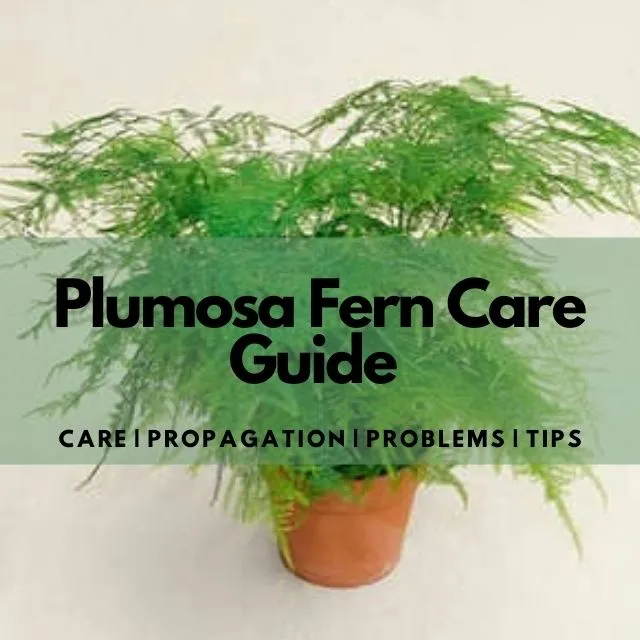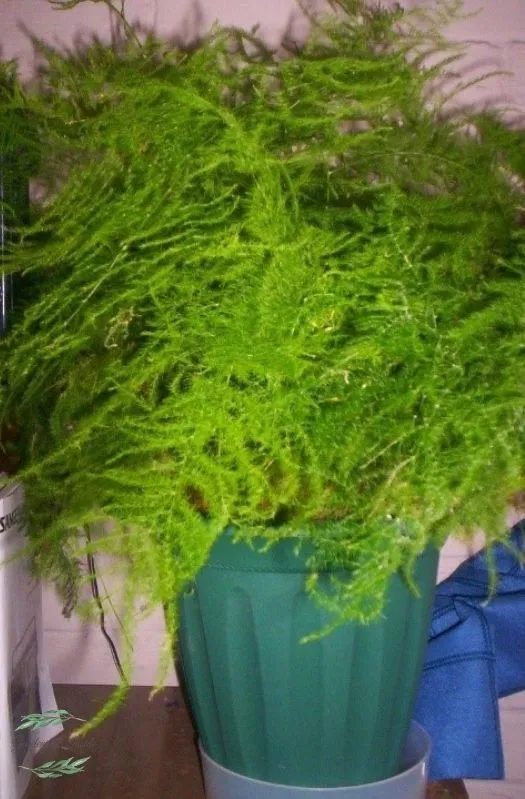Every grower demands to make his garden perfect by growing a range of beautiful plants, especially ornamental plants. Are you looking for some ornamental plants to make your garden beautiful? Here comes the beautiful Asparagus Plumosa Ferns!
Plumosa Fern is a beautiful plant that grows feathery clumps giving a soft look to your garden. These plants resemble ferns and have soft leaves, due we cannot state these plants as the true ferns.

Characteristic Features of Plumosa Ferns:
One of the perfect features of this plant is that it is easy to grow, and it does not demand much attention from you. Plumosa fern is low maintenance due to which it can tolerate changes within the watering frequency.
Also, the only thing that the plant demands from you is to protect it from the direct and harsh sunlight. So, place your plant in a welcoming environment and help it grow beautifully with an airy appearance.
What are the uses of Plumosa Ferns?
The everyday use of Plumosa ferns is growing the plant in hanging baskets. Also, you can place it in any container, including the combination planters.
The best thing is that if you want to cover your plant with greenery, then choose this fantastic plant.
Key details and Features of Plumosa ferns:
Here’s a table that you can look upon to have a brief look at the critical details of the plant:
| Category of the plant | Annual |
| Origin | South and East Africa |
| Scientific name | Asparagus setaceus |
| Family | It is a member of the Liliceae family. |
| Available colors | Green foliage |
| Height | 1 to 5 inches |
| Blooming time | Does not bloom (only grown for foliage) |
| The lowest temperature that plant can bear | 20-to-30-degree Fahrenheit |
| Light requirements | Sun to partial shade (avoid harsh direct sunlight) |
| Companion plants | Impatiens, Begonia, Coleus |
| Toxicity | Toxic the dogs and cats. |
| USDA Zone | 9-12 |
What do Plumosa ferns need to Grow Fast?
Here are some of the critical points that you need to consider for growing plumosa ferns in your garden:
- One must apply fertilizer to the plant monthly.
- The soil must be well-draining and should remain moist.
- Soil for the plant must be rich in nutrients.
- Additional care is also required for propagation, reporting, pests management, and diseases.
Also Check: Complete Hoya Macrophylla Care Guide with Pro Tips
Step by Step Plumosa fern Care
If you have decided to grow this soft-leaved plant in your garden, you must also have an idea about the care requirements. The following are some conditions in which it grows best:
Light requirements for plumosa fern:
You must know that the perfect place to grow plumosa fern is indoors, as it can receive perfect light here. The foliage of the plant will grow ideally in the partial shade. So it would be best if you did not let the plant grow in direct sunlight.
The direct bright light can scorch the plant, and it can also impact the bright green color of the foliage. You must also know that deficiency of light can result in yellowing of the leaves.
Pro tip:
If you are growing in a place where there is not enough light, don’t worry, and buy sources for artificial light. You will see the beautiful and fresh green color of the foliage.
How often must I water Asparagus Plumosa Fern?
Keep this thing in mind that these plants love to grow in moist soil. So, whenever you water it, make sure that the plant completely absorbs it.
The frequency of watering this plant is 2 to 3 days within a week. Consider both the soil and weather conditions while watering the plant.
The fact to consider:
Do not splash water directly on the foliage, as it can increase the chances of fungal growth.
Some pro tips to consider while watering plumosa ferns:
- You must use a good quality of water (avoid hard water). Rainwater is the best one to water your plant, and you can also use filtered tap water.
- Water the plant based on the watering schedule that you have selected.
- Make sure that it provides good drainage.
Humidity preferences:
Plumosa ferns do not love growing in low humidity conditions, and the favorable humidity in which the plant loves to grow is about 70%. If you are using it in low humidity, consider misting it or use a humidifier.
You know what, it loves occasional misting.
Pro tip:
A laid-back approach that you can use is to use a pebble tray having water inside. It will help in maintaining humidity.
Temperature requirements:
The ideal temperature range to keep your plant happy ranges from 65 to 75 degrees Fahrenheit. But the good news is that it can also tolerate 20 to 30 degrees Fahrenheit.
Plumosa fern can grow ideally indoors as the temperature does not change drastically there. So, keep your indoor temperature moderate and let your plant grow happily.
Pro tip:
These plants love to grow in moist soil, so sudden fluctuations of high temperature can impact the plant’s growth. At higher temperatures, misting will be a perfect option.
Soil requirements:
If you love to see your plant grow well with lush green foliage, then prepare a good potting mix for your plant. The right mixture that you can use includes sand and peat moss. Also, you have to choose a well-draining pot.
The addition of the fertilizer within the soil will help in the fast growth of the plant. You need to provide your lant with the right amount of nutrients with a pH of less than 6. It will help in maintaining a perfect environment for the growth of the plant.
Fertilizer requirements:
Fertilizing the plant from time to time keeps it healthy and will also contribute to fast growth. You can choose any fertilizer for your plant as per your preferences. Here are some of the common fertilizers that you can choose for the growth of your plant:
- You can use both liquid or granular fertilizer as per availability.
- Synthetic fertilizers will be a sustainable option as compared to organic fertilizers.
The right time to fertilize your plant is from spring to September. These are the growing seasons and will help you maintain your plant.
However, avoid fertilizing your plant in the winter season.
You May Also Like: Complete Guide Rhaphidophora Tetrasperma: How to Care & Grow
How does Pruning need to be done in the case of Plumosa ferns?
Plumosa ferns also demand pruning from time to time just to maintain the plant’s overall appearance. Annual pruning is recommended to maintain the healthy growth of the plant. Also, it will help in removing the yellow or brown leaves from the plant.
Here are the steps that you can follow to prune your plant:
- It would help if you chose a sharp and sterilized knife to proceed with the pruning.
- Pinching is also supported to encourage the dense growth of the plant.
- Remove both the yellow and brown colored leaves from the plant.
- Cutting the long leaves is also recommended.

How to Repot Plumosa ferns?
Plumosa ferns need repotting every spring, especially when the plant’s roots are bound to each other. You can examine the need for repotting by looking if the water is drained from the pot or not.
Failure to do repotting can result in damaging the roots. The following steps need to be followed by you for repotting your beautiful foliage plant:
- The first step is to remove the root ball from the container.
- After that, shake the root ball to remove excessive dirt and check if there are any signs of damage.
- Trim the bushy or damaged roots using a sterilized knife or cutter.
- Choose a pot of larger size and place the plant in that pot.
- Congratulations, you successfully did repot.
Plumosa Ferns Propagation
Propagating this plant is relatively easy, and you do not have to struggle much. The two different ways you can propagate your plant are either by root division or the seeds. Both these methods will help in the successful propagation of your plant.
How to Propagate Plumosa fern using root division?
- The first step is to remove the plumosa plant from the pot; after that, shake it to loosen the soil.
- Find out the root tubers and pull apart one of those in different sections.
- The next step is to cut the root tuber using a knife.
- The last step is to put the separated root tuber within a suitable pot.
- Water it and place it in a partial shade.
How to Propagate asparagus ferns using Seeds?
- Buy the seeds of asparagus plumosa fern from an authentic seller like Amazon or eBay.
- Soak these seeds in water for two to three days.
- Discard the seeds that are floating on the water.
- Place the seeds in the soil and provide it with water and light.
- Keep the environment warm and moist.
- You will see your seeds sprout in two to three weeks.
What are the problems faced by plumosa fern?
If the plants are not provided with the right growing conditions, it can create challenges. Some of the common problems your plant mainly faces include pests attacks, yellowing, and leaves browning.
Pests attack:
Pests attack is a rare issue faced by Plumosa fern, and commonly scales and the mealybugs attack the plant. The attack by these pests can weaken the plant’s growth, and you need to choose an appropriate solution to deal with this issue.
Solution:
Plumosa fern Yellowing Leaves:
One of the common reasons for the yellowing of the asparagus ferns is too much sunlight. Prolonged exposure to unwanted conditions can result in the yellowing of the leaves. Mismanagement in water conditions can also cause this issue.
Another reason for this issue is the plenty of warm and humid conditions.
Solution:
Plumosa fern Browning of Leaves:
Sunburn is the common cause that results in the browning of the plumosa ferns. The plant cannot bear sunlight conditions, and it can be also be caused due to plant diseases, including root rot or crown rot.
Solution:
Final thoughts:
Plumosa fern is a commonly grown plant due to its lush green foliage and fern-like appearance. It is easy to grow and maintain and does not demand much from you. You can quickly grow the plant without facing any barriers.
Plumosa fern will be a perfect choice for your garden and its green foliage, creating a refreshing look at your place. Happy growing!
Frequently Asked Questions about Plumosa Fern
Is plumosa toxic for my pet cat?
Yes, plumosa fern is a toxic plant and can cause health issues. Also, it can result in causing digestive problems, abdominal pain, and diarrhea.
What are the commonly used methods to propagate plumosa ferns?
The two standard methods used to propagate plumosa fern are by seeds or the root division method. You can easily use these methods to propagate your beautiful plant.
What steps are followed to prune the plumosa fern?
- It would help if you chose a sharp and sterilized knife to proceed with the pruning.
- Pinching is also supported to encourage the dense growth of the plant.
- Remove both the yellow and brown colored leaves from the plant.
- Cutting the long leaves is also recommended.
